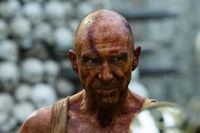Nearly a quarter-century after revolutionizing the zombie genre with the 2002 cult classic 28 Days Later, director Danny Boyle and screenwriter Alex Garland have reunited to deliver 28 Years Later, a bold but divisive new chapter set in a post-apocalyptic Britain quarantined from the rest of the world. This long-awaited sequel, marking 28 years since the original outbreak of the Rage virus, is the first installment in a planned trilogy that revisits the harrowing world of infected humans while weaving in fresh themes reflecting today’s political and cultural anxieties.
The film opens on a small island off the Scottish coast, connected to the mainland by a causeway that disappears at high tide. This isolated enclave, inhabited by uninfected survivors, lives a starkly preindustrial existence reminiscent of medieval villages. Farming, fishing, and communal rituals dominate daily life, with one particularly grim tradition: young men must journey to the mainland to prove their manhood by killing at least one infected creature using a bow and arrow. This rite of passage is both a coming-of-age test and a brutal reminder of the persistent threat lurking just beyond their shores.
At the center of the story is 12-year-old Spike (Alfie Williams), a sensitive boy facing his first mainland expedition alongside his father Jamie (Aaron Taylor-Johnson). Spike’s mother, Isla (Jodie Comer), is bedridden with a mysterious illness unrelated to the Rage virus, which compels Spike to later defy island protocol by sneaking her onto the mainland in search of medical help. Their perilous journey introduces them to a range of terrifying infected variants, including the familiar fast-moving “infected,” grotesque slow-and-lows—obese, worm-eating creatures that crawl—and formidable “alphas,” supersized mutants who dominate the packs with brutal intelligence and strength.
Adding complexity to this post-pandemic world is the enigmatic Dr. Ian Kelson (Ralph Fiennes), a reclusive figure who paints his body with iodine to resist infection and has adapted to coexist with the infected hordes. Fiennes’ presence brings a rare moment of gravitas and moral ambiguity to the film, hinting at deeper mythology that will be explored in the upcoming sequel, 28 Days Later: The Bone Temple. His performance, alongside Comer’s nuanced portrayal of Isla, grounds the movie’s emotional core amid its chaotic action sequences.
Filmed with a daring and innovative approach, cinematographer Anthony Dod Mantle utilized a custom rig mounting up to 20 iPhones simultaneously, allowing for rapid cuts and multiple angles that give the action scenes a fragmented, almost punk-rock immediacy. This technique, combined with freeze-frames and dramatic canted angles, creates a visceral, if sometimes disorienting, viewing experience that reflects the film’s themes of societal fragmentation and uncertainty.
While the film delivers on gore and thrills—featuring memorable moments like an alpha infected wielding a human head as a mace—it also serves as a reflection of contemporary fears. The setting of an isolated, quarantined Britain resonates with post-Brexit and post-COVID realities, underscoring themes of nationalism, isolationism, and the weaponization of culture. Yet, as some critics have noted, these allegorical layers are never spelled out explicitly, allowing the audience to interpret the subtext amidst the visceral horror.
The film’s narrative, however, has drawn mixed reactions. Some view it as a messy but visually extravagant addition to the franchise, struggling to find emotional coherence or fully develop its characters—particularly Isla, whose illness and motivations remain frustratingly vague. Others appreciate its mythic and sentimental undertones, especially the mother-son relationship that humanizes the apocalypse. The inclusion of a young protagonist like Spike is a risky but largely successful choice, with Williams delivering a performance that brings vulnerability and courage to the harrowing story.
As the film progresses, Spike’s journey takes him beyond the island’s protective boundaries, where he encounters not only infected threats but also survivors like a surly Swedish soldier (Edvin Ryding), who introduces the boy to relics of the pre-virus world such as a machine gun and a now-useless cellphone. These encounters highlight the stark contrast between the isolated island society and the chaotic mainland, emphasizing the fractured state of humanity.
Importantly, 28 Years Later also addresses the evolution of the infected themselves. The virus has mutated over nearly three decades, giving rise to new and more dangerous forms. The slow-and-lows, with their grotesque worm-eating habits, add a layer of unsettling horror, while the alphas represent a terrifying escalation of the virus’s threat. This biological evolution mirrors the societal shifts the film explores, suggesting that both the virus and humanity are locked in a relentless cycle of adaptation and survival.
Behind the gore and action, the film wrestles with enduring questions about what it means to be human when the line between monster and man blurs. Boyle himself has described the original 28 Days Later as “not a film about monsters — it’s a film about us,” and this sequel continues that introspection amid its post-apocalyptic chaos.
Despite its ambitious scope and innovative filmmaking, 28 Years Later is not without its flaws. Critics have pointed out tonal inconsistencies and a sometimes disjointed narrative that may leave viewers struggling to connect emotionally. The film’s sprawling ideas occasionally feel uncontained, and its pacing—fast and frenetic—can verge on overwhelming, particularly for those less enamored with visceral horror. Yet, for fans of the franchise and genre enthusiasts, the movie offers plenty of thrills, chills, and a fresh take on a beloved post-apocalyptic mythos.
The closing moments of the film set the stage for the next chapter in the trilogy, introducing new characters and mysteries that promise to deepen the mythology. Notably, actor Jack O’Connell teases the forthcoming sequel, The Bone Temple, directed by Nia DaCosta, with original star Cillian Murphy expected to reprise his role. This continuation suggests that Boyle and Garland are committed to evolving the franchise, potentially steering it in new and unexpected directions.
In sum, 28 Years Later is a visually inventive and thematically rich, if uneven, addition to the zombie genre. It revisits familiar territory with fresh eyes, blending horror, thriller, and coming-of-age elements against the backdrop of a quarantined Britain grappling with its fractured identity. While it may not fully satisfy all viewers, its ambition and moments of emotional resonance ensure it remains a noteworthy entry in the evolving saga of the Rage virus.



